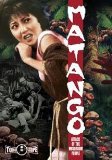Ishiro Honda is, of course, best known and (deservedly) beloved for his classic kaiju eiga: he not only directed the first appearances of Godzilla, Rodan, and Mothra, he also delivered many of their subsequent adventures, wrapping things up with 1975’s Terror of Mechagodzilla, which would be the last such entry until the mid-80s revival. The high profile of the giant monster movies has a tendency to overshadow some of this other contributions to fantastic cinema. One such effort which shouldn’t be overlooked is the inventive and grim Matango (1963).
A rich entrepreneur and his guests head off for a holiday on his yacht. When the weather turns nasty, he overrules his captain, who wants to turn back, and, in a misplaced display of machismo, orders that the course be maintained. The results are inevitable: the yacht is damaged beyond repair, and drifts aimlessly, until the unfortunate characters come across a deserted island. They soon discover that theirs is not the only shipwreck on these shores: they find a much larger ship, whose crew has vanished. Covering many of the ship’s surfaces is an unpleasant fungus. Our heroes clean the ship up, make it their home, and set about scavenging food, staying away from the abundant mushrooms, which are apparently toxic. But alternatives are in scant supply. Frictions mount, betrayals multiply, and one by one, the survivors succumb to the temptation of the mushrooms. These are not only addictive, they slowly transform you into one of them.
The look of the film at times anticipates Hammer’s The Lost Continent (1968), most notably the first appearance of the larger ship. There’s a misty, nightmare-storybook quality to the images here that are light years distant from the monster mashes. The mushroom monsters, meanwhile, might, if taken out of context, be laughable, but in fact they are quite disturbing, like the denizens of H. R. Pufnstuf as filtered through a bad acid trip.
Also notable is the film’s tone. The story is relentlessly grim, and works out its fantasy logic with terrible implacability. There is not a grain of mercy to be had here, and thus the film can come as something of a jolt to viewers more accustomed to Honda’s more typical 60s efforts. This darkness does not come out of the blue, however (if you will allow me to thus mix my metaphor). The original Gojira (1954), after all, remains the bleakest giant monster movie ever. The two films are valuable reminders of Honda’s tonal range as a director.
The Tokyo Shock release is regrettably free of extras. However, it does present a very nice widescreen transfer of the film, which has been very little seen on these shores. So there we are: creepy rubber suits, backstabbing characters, dangerous addicts (which have certain parallels with the infectious zombies George Romero would unleash five years later), and a thoroughly downbeat scenario. How can you resist the mushroom? You know you can’t.


